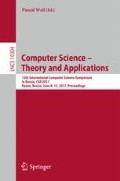Abstract
Edit distance \(\ell \)-neighbourhood of a formal language is the set of all strings that can be transformed to one of the strings in this language by at most \(\ell \) insertions and deletions. Both the regular and the context-free languages are known to be closed under this operation, whereas the deterministic pushdown automata are not. This paper establishes the closure of the family of input-driven pushdown automata (IDPDA), also known as visibly pushdown automata, under the edit distance neighbourhood operation. A construction of automata representing the result of the operation is given, and close lower bounds on the size of any such automata are presented.
Access this chapter
Tax calculation will be finalised at checkout
Purchases are for personal use only
References
Aho, A.V., Peterson, T.G.: A minimum distance error-correcting parser for context-free languages. SIAM J. Comput. 1(4), 305–312 (1972). http://dx.doi.org/doi/10.1137/0201022
Alur, R., Madhusudan, P.: Visibly pushdown languages. In: ACM Symposium on Theory of Computing, STOC 2004, Chicago, USA 13–16 June 2004, pp. 202–211 (2004). http://dx.doi.org/10.1145/1007352.1007390
Alur, R., Madhusudan, P.: Adding nesting structure to words. J. ACM 56(3) (2009). http://dx.doi.org/10.1145/1516512.1516518
von Braunmühl, B., Verbeek, R.: Input driven languages are recognized in log \(n\) space. Ann. Discrete Math. 24, 1–20 (1985). http://dx.doi.org/10.1016/S0304-0208(08)73072-X
Caucal, D.: Synchronization of pushdown automata. In: Ibarra, O.H., Dang, Z. (eds.) DLT 2006. LNCS, vol. 4036, pp. 120–132. Springer, Heidelberg (2006). doi:10.1007/11779148_12
Chatterjee, K., Henzinger, T.A., Ibsen-Jensen, R., Otop, J.: Edit distance for pushdown automata. In: Halldórsson, M.M., Iwama, K., Kobayashi, N., Speckmann, B. (eds.) ICALP 2015. LNCS, vol. 9135, pp. 121–133. Springer, Heidelberg (2015). doi:10.1007/978-3-662-47666-6_10
Han, Y.-S., Ko, K., Salomaa, K.: Approximate matching between a context-free grammar and a finite-state automaton. Inf. Comput. 247, 278–289 (2016). http://dx.doi.org/10.1016/j.ic.2016.02.001
Han, Y.-S., Salomaa, K.: Nondeterministic state complexity of nested word automata. Theoret. Comput. Sci. 410, 2961–2971 (2009)
Kutrib, M., Malcher, A., Wendlandt, M.: Tinput-driven pushdown automata. In: Durand-Lose, J., Nagy, B. (eds.) MCU 2015. LNCS, vol. 9288, pp. 94–112. Springer, Cham (2015). doi:10.1007/978-3-319-23111-2_7
Mehlhorn, K.: Pebbling mountain ranges and its application to DCFL-recognition. In: Bakker, J., Leeuwen, J. (eds.) ICALP 1980. LNCS, vol. 85, pp. 422–435. Springer, Heidelberg (1980). doi:10.1007/3-540-10003-2_89
Mohri, M.: Edit-distance of weighted automata: general definitions and algorithms. Int. J. Found. Comput. Sci. 14(6), 957–982 (2003)
Han, Y.-S., Ko, S.-K., Salomaa, K.: Generalizations of code languages with marginal errors. In: Potapov, I. (ed.) DLT 2015. LNCS, vol. 9168, pp. 264–275. Springer, Cham (2015). doi:10.1007/978-3-319-21500-6_21
Ng, T., Rappaport, D., Salomaa, K.: Descriptional complexity of error detection. In: Adamatzky, A. (ed.) Emergent Computation. ECC, vol. 24, pp. 101–119. Springer, Cham (2017). doi:10.1007/978-3-319-46376-6_6
Okhotin, A.: Input-driven languages are linear conjunctive. Theoret. Comput. Sci. 618, 52–71 (2016). http://dx.doi.org/10.1016/j.tcs.2016.01.007
Okhotin, A., Salomaa, K.: Complexity of input-driven pushdown automata. SIGACT News 45(2), 47–67 (2014). http://doi.acm.org/10.1145/2636805.2636821
Okhotin, A., Salomaa, K.: Descriptional complexity of unambiguous input-driven pushdown automata. Theoret. Comput. Sci. 566, 1–11 (2015). http://dx.doi.org/10.1016/j.tcs.2014.11.015
Okhotin, A., Salomaa, K.: State complexity of operations on input-driven pushdown automata. J. Comput. Syst. Sci. 86, 207–228 (2017). http://dx.doi.org/10.1016/j.jcss.2017.02.001
Piao, X., Salomaa, K.: Operational state complexity of nested word automata. Theoret. Comput. Sci. 410, 3290–3302 (2009). http://dx.doi.org/10.1016/j.tcs.2009.05.002
Pighizzini, G.: How hard is computing the edit distance? Inf. Comput. 165, 1–13 (2001)
Povarov, G.: Descriptive complexity of the Hamming neighborhood of a regular language. In: LATA 2007, pp. 509–520 (2007)
Salomaa, K., Schofield, P.N.: State complexity of additive weighted finite automata. Int. J. Found. Comput. Sci. 18(6), 1407–1416 (2007)
Seki, H., Matsumura, T., Fujii, M., Kasami, T.: On multiple context-free grammars. Theoret. Comput. Sci. 88(2), 191–229 (1991). http://dx.doi.org/10.1016/0304-3975(91)90374-B
Terrier, V.: Recognition of linear-slender context-free languages by real time one-way cellular automata. In: Kari, J. (ed.) AUTOMATA 2015. LNCS, vol. 9099, pp. 251–262. Springer, Heidelberg (2015). doi:10.1007/978-3-662-47221-7_19
Author information
Authors and Affiliations
Corresponding author
Editor information
Editors and Affiliations
Rights and permissions
Copyright information
© 2017 Springer International Publishing AG
About this paper
Cite this paper
Okhotin, A., Salomaa, K. (2017). Edit Distance Neighbourhoods of Input-Driven Pushdown Automata. In: Weil, P. (eds) Computer Science – Theory and Applications. CSR 2017. Lecture Notes in Computer Science(), vol 10304. Springer, Cham. https://doi.org/10.1007/978-3-319-58747-9_23
Download citation
DOI: https://doi.org/10.1007/978-3-319-58747-9_23
Published:
Publisher Name: Springer, Cham
Print ISBN: 978-3-319-58746-2
Online ISBN: 978-3-319-58747-9
eBook Packages: Computer ScienceComputer Science (R0)

